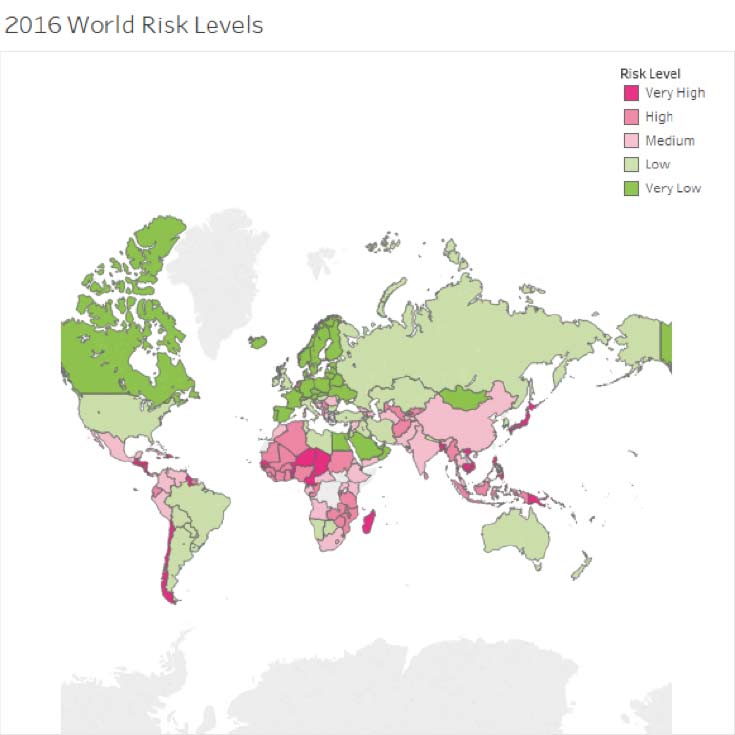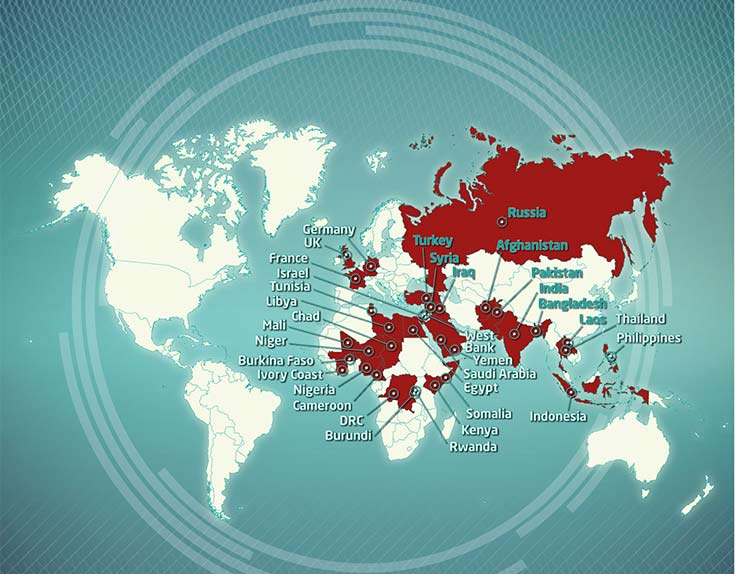World Risk Report 2016: The Importance of Infrastructure
The Institute for Environmental and Human Security, part of United Nations University published its annual World Risk Report on August 25, 2016. The report focuses on the consequences of possible extreme natural events in 171 countries, reports Roger Gomm for CRJ.
Every year the World Risk Report (WRR) and its World Risk Index (WRI) analyse the exposure and vulnerability to natural hazards of over 170 countries, in order to assess the drivers and hotspots of disaster risk.

The World Bank estimates that up to an additional US$1.5 trillion annually will be necessary through 2020 to help low and medium-income countries establish adequate levels of infrastructure. The greatest needs are investments in electricity, water and transport infrastructure. There are many similarities between this map and the map further down, which illustrates countries that have experienced terrorist attacks between January and May 2016
A key strand of this report that will interest readers is that it provides analyses of the role that infrastructure plays in shaping a country’s disaster risk. When an extreme environmental hazard strikes, infrastructure can be a deciding factor in whether or not the situation becomes a disaster. Roads, for example, can provide access to quickly supply relief aid to affected communities; but if roads are destroyed, entire regions can be cut off from support.
The World Risk Index, calculated by the University of Stuttgart, is an integral part of the report as it ranks 171 countries according to their risk of becoming a victim of a disaster as a result of natural hazards such as floods, cyclones, or earthquakes.The World Risk Index is particularly interesting, as the major component of each country’s index score is its exposure to natural hazards, referring to the percentage of population living within the reach of potential hazards such as floods, storms, earthquakes, tsunamis, droughts, and sea-level rise.
The index also analyses a country’s vulnerability, which is the country’s tendency to suffer harm when being hit by a natural hazard.Of the top 15 countries with the highest vulnerability in this year’s index, 13 are located in Africa (the exceptions being Haiti and Afghanistan). These countries face a high damage potential when hit by a natural hazard due to, for example, inadequate health care provision, sanitation, and secure habitation.
The 2016 World Risk Index ranks the Pacific island states of Vanuatu and Tonga as 1 and 2, respectively, meaning that they have the highest levels of risk (see CRJ 12:4). Global hotspot regions meanwhile, are in Oceania, Southeast Asia, Central America, and the Southern Sahel.
The report argues that proper development and maintenance of critical infrastructure needs to be understood as a core component of disaster risk reduction. In Africa, for example, there are only 65 kilometres of paved roads per 100,000 inhabitants, compared with 832 kilometres in Europe or 552 kilometres in the Americas. This means that there are fewer redundancies in transportation routes and, consequently, fewer alternatives if the main road to an affected area becomes impassable.
Critical infrastructure, meaning infrastructure that is of key importance for the functioning of a society at large, is very susceptible to cascading effects. Different sectors of critical infrastructure often depend on each other, and therefore the system as a whole is more susceptible to crises. The collapse of a power supply, which happened during Hurricane Sandy in 2012 for example, can hinder disaster logistics that are heavily dependent on information and communication technologies. So even if roads or bridges have not been destroyed, their usability can be diminished if other infrastructure elements are compromised.
The World Bank estimates that up to an additional US$1.5 trillion annually will be necessary through 2020 to help low and medium-income countries establish adequate levels of infrastructure. The greatest needs are investments in electricity, water and transport infrastructure.
In the May 2016 Edition of CRJ (11:4) I wrote an article about Terrorism: The Threat Picture. This piece contained a map that showed the countries that have experienced a terrorist attack (a malicious threat) since January 1, 2016 until publication, including attacks by violent non-state actors, lone wolf and politically or ideologically motivated knife attacks. There are many similarities in the two maps and the countries involved.

Map published in the May 2016 edition of CRJ showing the countries that have experienced a terrorist attack between January 1, 2016 and May, including attacks by violent non-state actors, lone wolf and politically or ideologically motivated knife attacks (CRJ / Tim Baggaley)
In my opinion, governments, businesses, large and small and communities must help mitigate the risks. The World Economic Forum (WEF) Global Risk Report 2016 states: “Increasingly, businesses need to strengthen their scenario and emergency planning capacity to analyse complex and often uncertain interdependencies if they are to build resilience to global risks.”
It also asks for private sector leaders to place international security firmly on their radar screen. The WEF warns that international security and geopolitical trends are likely to have more influence on the global economy in the future, thus demanding greater strategic attention from business leaders. With a stronger understanding of the issues and their own evolving role in the geopolitical and global safety and security landscape, the private sector can be a constructive partner in addressing many global challenges and mitigating risks.
A full copy of the World Risk Report can be viewed here.
Roger Gomm QPM is an Advisor, Trainer, Consultant and Associate Lecturer, Cabinet Office Emergency Planning College, UK, and a Member of CRJ's Editorial Advisory Panel
Roger Gomm, 31/08/2016